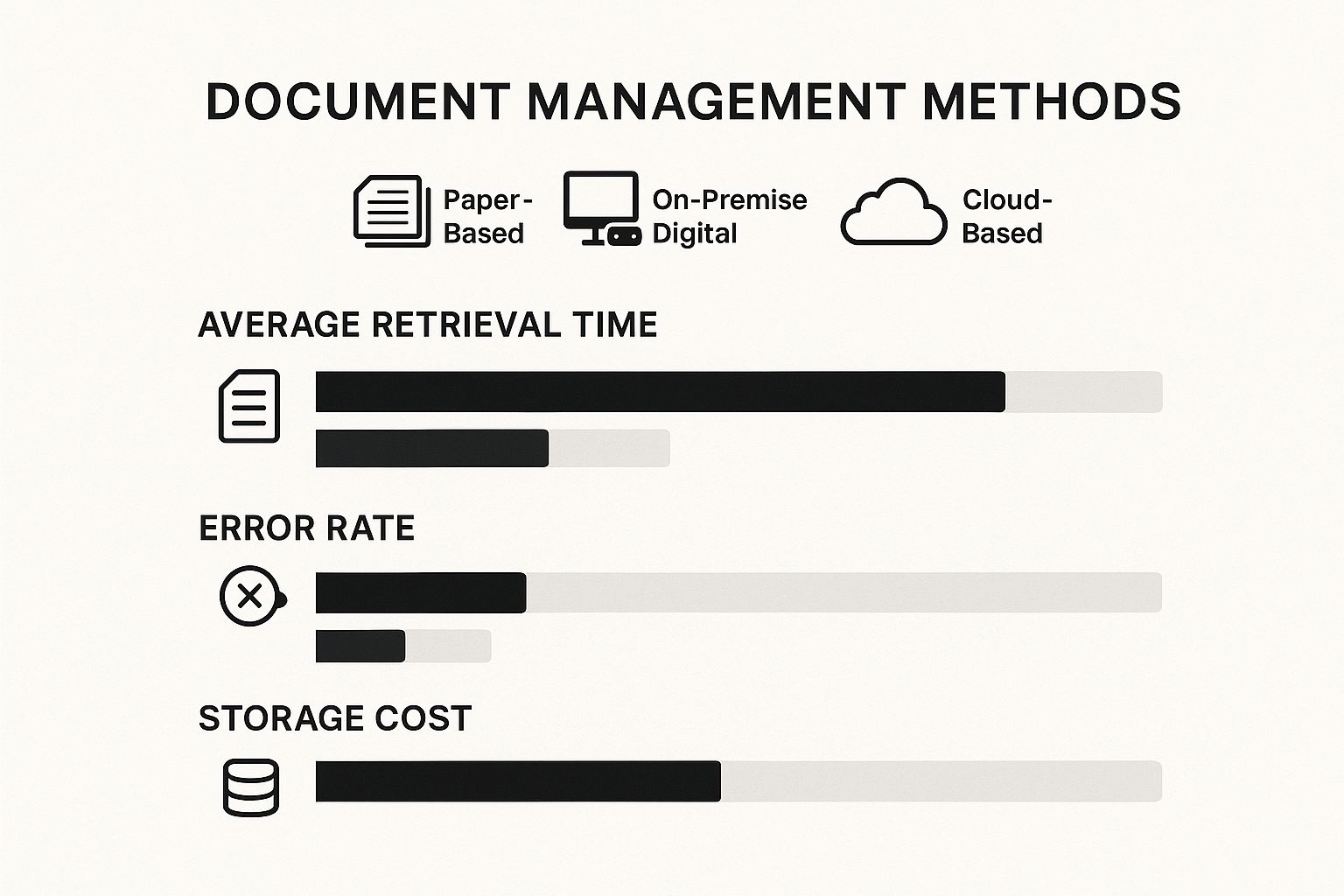Ever tried to build a complex Lego set without the instructions? You might get something that looks like the picture on the box, but it's probably unstable and missing key pieces. That's what running a construction project without solid documentation management feels like—a surefire recipe for chaos, expensive rework, and a project that goes off the rails.
So, what is construction documentation management? It's the disciplined, systematic process of handling every single piece of paper and digital file a project generates. This means creating, organizing, sharing, and archiving everything to keep the entire team—from the architect to the subcontractor—on the same page and the project moving forward.
The Blueprint for Project Success

Let's be clear: this isn't just about digital filing or fancy clerical work. At its core, good documentation management is the central nervous system of any build. It governs the flow of critical information from the very first conceptual drawing all the way to the final, signed-off punch list.
Think of it like this: the project documents are the structure's DNA. They hold the precise code for bringing the building to life exactly as the client, architect, and engineers envisioned it. If that code gets corrupted, goes missing, or is read incorrectly, the results can be catastrophic.
A robust management system is all about getting the right information into the right hands at exactly the right time. It’s what stops a crew from framing a wall based on an outdated blueprint or an engineer from overlooking a critical RFI response. This proactive control is what separates well-run, profitable jobs from the ones that bleed money and time.
A Growing Industry Imperative
This push towards organized, digital systems isn't just a passing trend; it's a fundamental shift in how the industry operates. The global market for document management systems, which includes powerful tools built for construction, was valued at around USD 9.35 billion in 2024. Experts project it will explode to over USD 55.61 billion by 2037. You can dig into the market dynamics to see just how fast things are changing.
That explosive growth highlights one simple truth: trying to manage a modern project's mountain of paperwork with spreadsheets and email is no longer a viable option for firms that want to stay competitive.
A project’s documentation is its single source of truth. When that truth is scattered, outdated, or inaccessible, the project loses its foundation long before the first concrete pour.
Key Document Types in Construction Projects
A single construction project can easily generate thousands of documents, each serving a distinct purpose for a specific audience. Understanding the role of each document type is the first step toward managing them effectively.
The table below breaks down the main categories of documents you'll encounter on almost any job site.
From planning documents to closeout files, each piece of information plays a vital part in the project's journey.
Ultimately, great construction documentation management is about creating a predictable, controlled, and transparent environment. It gives every stakeholder, from the owner to the boots on the ground, the confidence to do their job right the first time. It turns a potential liability—a mountain of paperwork—into a powerful strategic asset.
Navigating Common Document Management Pitfalls

When you don't have a solid system for construction documentation management, it's not just a minor hiccup. It's a recipe for chaos. Picture this: a subcontractor is busy framing a wall based on drawings from three weeks ago. He has no idea a critical change order just shifted every electrical outlet. That mistake won't surface for days, forcing everyone to stop, tear it out, and start over. That’s pure cost and delay.
This isn’t some made-up horror story. It’s a daily reality on job sites that struggle with document control. The fallout from these small misses snowballs, eating into profits, blowing up timelines, and creating a ton of friction between teams that should be working in sync.
Without one central, organized hub for information, projects inevitably hit a few all-too-familiar roadblocks. These problems feed into each other, creating a domino effect that can knock a whole project off its tracks.
The Problem of Information Silos
We've all seen it. Project documents are all over the place—some in email inboxes, others on local desktops, and a few scattered across different cloud services. This creates information silos. The architects might have the very latest design revision, but the crew in the field is still working off a PDF they downloaded last week.
This kind of disconnect is a massive source of inefficiency and risk. Key information gets trapped, completely out of reach for the people who need it to do their jobs. A critical RFI response clarifying a structural detail might be sitting unread in a PM’s inbox while the crew on-site has no choice but to guess and move forward.
It’s been estimated that a staggering 52% of all rework in construction stems from bad project data and miscommunication—problems that almost always start with siloed information.
The High Cost of Version Control Failures
This is probably the biggest and most expensive mistake of all: poor version control. On any active project, documents like blueprints, specs, and schedules are living, breathing things that change constantly. If you don't have a single source of truth, it’s a guarantee that different versions of the same file will start floating around.
The result? Confusion and costly mistakes. Think about what happens next:
- Building from Outdated Plans: A team spends days working from an old drawing, leading to major rework that torches both labor hours and expensive materials.
- Incorrect Material Orders: The procurement manager orders thousands of dollars in materials based on a spec sheet that’s already been updated.
- Failed Inspections: The crew completes work perfectly according to the plan they have, but it's not the latest compliant version. The inspector flags it, and the project grinds to a halt.
Every single one of these scenarios costs real money and precious time. Trying to manually track every revision across dozens of documents and stakeholders is a nightmare and just asking for human error.
Insecure Storage and Administrative Drag
Finally, a weak system opens the door to huge security risks and administrative headaches. Stashing sensitive contracts, bids, and financial records on unsecured platforms—or worse, in physical filing cabinets—leaves them vulnerable to being lost, stolen, or damaged.
Beyond the security risk, the sheer administrative drag of manual processes kills productivity. Your team can easily waste hours every week just trying to find the right document, chase down an approval, or piece together reports by hand. That's valuable time they could be spending on critical tasks that actually add value to the project. For any firm that wants to stay competitive, a structured approach to construction documentation management isn't a nice-to-have anymore. It's fundamental to staying profitable and simply surviving.
Core Principles for Flawless Document Control

So, how do we move past the chaos of disorganized files? The answer isn't just buying another piece of software; it's about adopting a playbook of core principles that turns your documentation from a headache into a real asset. A world-class construction documentation management strategy creates order and puts the right information in the right hands, every single time.
First things first: you absolutely must establish a single source of truth (SSOT). Think about a library where dozens of different versions of the same book are scattered on random shelves. That’s a construction project without an SSOT, and it’s a recipe for disaster. An SSOT ensures that everyone—from the architect in the office to the foreman on-site—is working from the exact same set of plans, contracts, and RFIs.
This is more than just a shared folder. It's a firm commitment to one authoritative location for all project data. When a new drawing version gets approved, the old one is archived, and the new one takes its place in the SSOT. This simple discipline eliminates the massive risk of a crew building from outdated information.
Create Standardized Naming Conventions
Once you have that single source of truth, you need a way to find things in it. That's where standardized naming conventions come into play. Without them, your central repository quickly becomes a digital junk drawer filled with useless file names like "Final_Blueprint_v2_updated.pdf" or "ChangeOrder_Jasons_Notes.docx."
A solid naming convention is like a GPS for your documents. It creates a consistent, predictable structure that makes finding what you need completely intuitive. A good system usually includes a few key identifiers:
- Project Number: The unique code for the job (e.g., 2024-015).
- Document Type: A clear label for the file type (e.g., RFI, SUB, DWG).
- Version Number: A simple way to track revisions (e.g., v1, v2, v3).
- Date: A consistent format is key (e.g., YYYY-MM-DD).
For instance, a file named 2024-015_DWG-A101_v3_2024-08-15.pdf tells you everything you need to know at a glance. It's the third version of architectural drawing A101 for project 2024-015, approved on August 15, 2024. That clarity removes all the guesswork and saves a ton of time. Going beyond construction specifics, adopting good data management best practices is essential for any industry hoping to maintain flawless document control.
Implement Bulletproof Version Control
Version control is the engine that actually powers your single source of truth. It’s the hands-on process of managing document changes over time. A bulletproof system doesn't just save new files; it builds a clear and accessible audit trail of every single modification.
Every change, comment, and approval is logged automatically. This means if a dispute arises six months down the line about a specific change order, you can pull up the exact document, see who approved it, and when.
That kind of transparent tracking is just impossible with manual methods like email. Many firms are now turning to cloud-based platforms to solve this, which makes sense given the on-the-go nature of construction work. These systems provide real-time access and updates for everyone, no matter where they are.
Automate Workflows for Approvals and Distribution
The final piece of the puzzle is automating the flow of information. Manually emailing documents for approval, chasing people for signatures, and then trying to distribute the final version is a huge time-waster and full of potential for mistakes. Automated workflows handle all of that for you.
For example, when an RFI gets submitted, the system can automatically send it to the project architect. Once they respond, it can route it to the general contractor for review and then push it out to all the relevant subcontractors. Every step is tracked, and the system even sends reminders if someone is holding things up. This transforms a clunky, multi-day manual process into a smooth, hands-off operation. It makes your construction documentation management system work for you, not against you.
The Shift from Filing Cabinets to the Cloud
It wasn’t that long ago that the nerve center of any major construction project was a trailer packed with filing cabinets. Blueprints were actual, physical rolls of paper that someone had to drive out to the job site. Change orders were paper memos, and RFIs were stacks of carbon copies that could get lost, smeared, or ruined by a single spilled coffee.
This paper-heavy world was the norm for decades, but it was riddled with inefficiencies and risk. Finding one specific document could turn into an hour-long hunt. Worse, everything was vulnerable. A fire or a leak in the site office could literally erase the entire project history, leaving everyone flying blind. To truly appreciate how far we've come, it's worth exploring the benefits of going paperless.
The First Step: Digital, but Still Disconnected
The first real jump forward wasn't to the cloud, but to on-premise servers right in the main office. Companies started scanning documents and saving them on local hard drives. This was certainly an improvement—it offered better protection from physical damage and at least created digital backups.
But this created a whole new set of headaches. Access was usually chained to the office network, which meant the teams out in the field were still disconnected from the latest information. These local systems were also expensive and a pain to maintain, needing dedicated IT support, constant hardware upgrades, and complicated backup routines. Collaboration was still a mess, often just emailing files around, which brought back the nightmare of figuring out which version was the right version.
The move to digital was a step in the right direction, but keeping that data locked away on a local server was like buying a race car and only driving it in the parking lot. The real power was in connectivity.
This is where true, modern construction documentation management finally enters the picture. The industry's widespread move to cloud-based platforms has been the single biggest change in how project information gets managed.

As you can see, the jump to the cloud isn't just a small step—it's a massive leap in speed, accuracy, and cost-effectiveness.
Comparing Document Management Methods in Construction
This journey from paper to on-premise servers to the cloud marks a fundamental shift in how we access, share, and protect project information. Each method directly impacts a project's efficiency and, ultimately, its profitability. This table breaks down the key differences.
This evolution is about more than just convenience. It’s about building a more robust, efficient, and profitable way to manage construction. By moving to the cloud, we've torn down the old barriers that slowed projects to a crawl, creating a truly connected environment where everyone is on the same page.
How AI Is Reshaping Document Management
https://www.youtube.com/embed/5ZyVwBCWyhc
The move to the cloud was just the beginning. It set the stage for the next real leap in construction documentation management, and that leap is happening right now with Artificial Intelligence (AI). AI is taking those digital filing cabinets we've all gotten used to and turning them into active, intelligent partners on the project. This isn't some futuristic fantasy; it's a practical tool that is fundamentally changing how we handle information today.
Don't picture a robot taking over the job site. Instead, think of AI as a hyper-efficient assistant who never sleeps and never needs a coffee break. It can read, understand, and organize thousands of documents in minutes, freeing up your team to focus on what actually matters—building.
This technology isn't just about doing things faster. It's about adding a layer of intelligence that simply wasn't possible before. AI platforms automate the tedious, soul-crushing tasks that bog down project managers, allowing them to make critical decisions instead of drowning in digital paperwork.
From Manual Tagging to Smart Automation
One of the most immediate wins with AI is how it handles document classification. Traditionally, a project administrator would have to open every single file—an RFI, a submittal, a daily report—and manually tag it with the right information. It’s slow, boring, and a recipe for human error.
AI blows that whole process up. When you upload a new document, an AI model can instantly recognize what it is, pull out key details like dates and drawing numbers, and tag it correctly. All of this happens automatically, ensuring every file is perfectly organized and searchable from the second it hits the system.
This isn’t just a nice-to-have feature; it’s a massive efficiency boost. That’s why by late 2024, a staggering 77% of businesses were speeding up their adoption of document management tools, and 26% were increasing their investments specifically in automation. The North American market alone was worth $2.79 billion, showing just how essential these tools have become. You can dig into more document management statistics to see the full picture of this industry-wide shift.
Making Every Document Searchable
We've all been there. You have a mountain of scanned documents—old blueprints, signed contracts, field reports—that are essentially just pictures. You can't search for "HVAC unit specs" and expect the system to find it buried inside a scanned PDF. It's a huge blind spot in most archives.
AI-driven Optical Character Recognition (OCR) technology is the solution. It essentially “reads” the text and numbers on an image and converts them into searchable digital data.
Suddenly, your entire document archive comes to life. A project manager can type a specific part number or a material spec into the search bar and instantly pinpoint its location across thousands of documents, even scans from decades ago. Your archive transforms from a digital graveyard into a living, breathing database.
Proactive Clash Detection and Error Flagging
This is where AI goes from a helpful assistant to a true game-changer. Its ability to proactively spot problems before they ever make it to the field is a massive leap forward for risk management.
AI algorithms can analyze and compare different drawing sets—like architectural, structural, and MEP (Mechanical, Electrical, and Plumbing) plans—to find conflicts before they cost you time and money.
- Identifying Clashes: The system can automatically flag where a plumbing line runs through a structural beam or an HVAC duct collides with electrical conduit.
- Checking for Compliance: AI can also check drawings against project specs to make sure the right materials and standards are called out.
- Flagging Omissions: It can even spot what's not there, like missing fire-stopping details in a critical wall assembly.
Catching these issues in pre-construction prevents the incredibly expensive rework that happens when a clash is discovered during the build. This foresight delivers a clear return on investment, saving untold hours and material costs while making projects more predictable and successful.
Choosing the Right Management System for Your Firm
Picking the right platform for your firm’s construction documentation management isn't just about buying software. It’s a long-term investment in your project's efficiency, your team's sanity, and your company's bottom line. The goal is to find a system that doesn't just clean up your current document mess but can also grow and adapt with your business for years to come.
To make the right choice, you have to look past the flashy feature lists. What you really need is a solid decision-making framework that matches a platform’s capabilities to how your firm actually operates. Think about the complexity of your typical projects, the size of your teams, and all the regulatory hoops you have to jump through on every single job.
Assess Your Core Needs First
Before you even book a demo, take a hard look at your internal processes. Where are the real bottlenecks? Is it the disconnect between the field and the office? Are you constantly chasing down signatures for change orders? Or is version control an absolute nightmare? An honest self-assessment will create a clear shopping list of problems that need a solution.
Your evaluation should be built on a few non-negotiable pillars. Without these, even the most expensive software will fail to deliver any real return on investment.
Seamless Mobile Access: Your field crews are the lifeblood of every project. Any system that isn't designed for mobile-first access is already behind the times. Your team needs to pull up the latest drawings, fire off RFIs, and log daily reports directly from their phone or tablet, right there on the job site.
Enterprise-Grade Security: You're about to trust this platform with some of your most sensitive data—from bids and contracts to private client information. Look for systems with serious security protocols, like data encryption, detailed user permissions, and a clear audit trail that logs every single click and change.
Transparent and Scalable Pricing: Steer clear of platforms with confusing pricing and hidden fees. The cost structure should be simple and allow you to scale up or down as your workload changes. You want a partner whose pricing supports your growth, not one that punishes you for it.
Integrations and Future-Proofing Your Tech Stack
No software works in isolation. Your documentation management system has to play nice with the other tools you depend on every day, whether it’s your BIM platform, accounting software, or scheduling tools. This is where integrations become absolutely critical.
A platform's ability to connect with other software via APIs (Application Programming Interfaces) is what separates a true operational hub from just another data silo.
When you're evaluating a system, pay close attention to how well it integrates with your other essential software. Following general principles for effective API integration best practices can provide some great insights here. Good integration creates a smooth, automated flow of information across your entire business, which means no more manual data entry and a much lower risk of expensive mistakes.
In the end, choosing the right system is about finding a tool that makes everyone’s job easier. It should empower your team in the field, give project managers the clarity they need, and offer peace of mind to the folks in leadership. By focusing on these core requirements, you can select a construction documentation management solution that becomes a genuine strategic asset for your firm.
Your Questions, Answered
Jumping into a dedicated system for construction documentation always brings up a few questions. It's a big step, so let's clear up some of the common ones to help you feel confident in your decision-making.
What’s the Difference Between Document Control and Document Management?
It's easy to use these terms interchangeably, but they represent two sides of the same coin.
Think of document management as the library itself. It's the entire system for storing, organizing, and finding all your project files. It answers the "what" and "where" of your information—the digital filing cabinet for everything from blueprints to RFIs.
Document control, on the other hand, is the work the librarian does. It's the active process that governs the "who," "when," and "why" behind each file. This involves managing approvals, tracking different versions, and making sure the right people have the latest, most accurate information. You can't have good management without tight control.
How Do You Handle Document Security and Permissions?
Putting sensitive project data in one place naturally raises security questions. This is where modern construction documentation platforms really shine, giving you incredibly specific control over who sees what.
Here’s how to approach it:
- Role-Based Access: Set permissions based on someone's job. For example, an architect needs full editing rights on drawings, but a subcontractor might only need to view them.
- Action-Specific Permissions: Go deeper than just what people see by controlling what they can do. You can decide who has permission to view, download, edit, or approve specific types of documents.
- Complete Audit Trails: A solid system tracks every single action. It logs who viewed a file, when they downloaded it, and every change made. This creates a bulletproof record, which is crucial for accountability and settling any disputes down the line.
A smart permission setup keeps confidential data like bids and contracts locked down, while ensuring general documents are readily available to the teams that need them to do their jobs.
What Is the Best Way to Start Implementing a New System?
The thought of switching systems can feel like a massive undertaking, but the key is to start small and be strategic. Don't try to boil the ocean.
First, figure out your biggest headaches. What's the one problem that, if solved, would make the biggest immediate impact? Focus on that first.
Then, build a small, dedicated team to spearhead the change and get your key players on board. Run a pilot on a single project instead of attempting a company-wide rollout. This gives you a safe space to test your new process, collect feedback, and prove the system's value before expanding it. A phased approach like this makes the transition much smoother for everyone.
Tired of chasing down job notes and deciphering messy handwriting? Nora, the AI assistant from ResQ, automates your entire field documentation process through WhatsApp. Your team sends notes, and Nora handles the rest—creating clean, organized, and searchable job logs instantly. See how much time you can save by visiting the official Nora by ResQ website.



